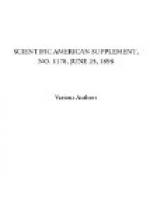Chronophotography presents no more difficulty than ordinary photography as regards the taking of negatives, and the amateur who has not the proper facilities for developing and printing the latter can have these operations performed by a professional. Animate projections are beginning to be introduced into parlors, and some day will entirely replace the magic lantern therein. The excitement caused by the catastrophe at the Charity Bazar is now calmed, and it has been ascertained that the accident was not due to the lamp of the projector, but to a carelessly handled can of ether. So the extension of this sort of spectacle, momentarily arrested, is taking a new impetus, which will be further aided by the apparatus under consideration, for the description of which and the illustrations we are indebted to La Nature.
* * * * *
THE RECLAIMING OF OLD RUBBER.
By Hawthorne Hill.
The complaint of high prices of India rubber is as old as the rubber industry, one result of which has been an unceasing effort to discover a practical substitute. Never was the secret of the transmutation of metals sought more persistently by ancient philosophers than the secret of an artificial rubber has been by modern chemists, but, thus far, the one search has been hardly more successful than the other. One discovery has been made, however, by which our rubber supplies have been so far conserved that, for the want of it, we might be obliged now to pay double the current prices for new rubber. This is the reclaiming of rubber from worn-out goods, in a condition fit for use again in almost every class of products of the rubber factory.
Soon after the vulcanization of rubber became fully established, attempts began to be made to “devulcanize” the scrap and cuttings of rubber which accumulated in the factories. So extensive were these accumulations that one company are reported to have built a road with rubber scrap through a swamp adjacent to their factory, while most other manufacturers were unable to find even so profitable a use for their wastes. As time advanced there came to be large stocks, also, of worn-out rubber goods, such as car springs and the like, all of which appealed to a practical mind here and there as being of possible value, since the price of new rubber kept climbing up all the while.
No fewer than nineteen patents were granted in the United States for “improvements in devulcanizing India rubber,” or “restoring waste vulcanized rubber,” beginning in 1855, or eleven years after the date of Goodyear’s patent for the vulcanization process. In that year Francis Baschnagel obtained a patent for restoring vulcanized rubber to a soft, plastic, workable state, by treating it with alcohol absolutus and carbon bisulphuratum, in a closed vessel, without the application of heat. Later he obtained a patent for accomplishing the same result by “boiling waste rubber in water, after it has been reduced to a finely divided state;” and still later, one for treating the waste to the direct action of steam.




